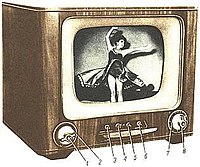Analog television

Imagine you have a toy car and you want to send it to your friend who lives far away. You can’t just toss the car to your friend because they are too far away, so you need to find another way to send it to them. Instead of the car, let's talk about sound and images that come from your TV.
Analog television is like a way to send those sounds and images to your TV from far away. Just like how you can’t toss the toy car to your friend, you can’t just send the sounds and images directly from the TV station to your TV. So, we need to convert them into something else that can be sent through the air.
In analog TV, the TV station takes the sound and images and turns them into a signal that can travel through the air. This signal is sort of like a wave, like the waves you see in a lake, but you can't see these waves. The signal gets sent out from the TV station and travels through the air to your TV. The waves of the signal bounce off things like buildings and trees as they travel.
When your TV receives the signal, it decodes it back into sounds and images that you can see and hear. Your TV then displays these images on the screen and plays the sound through the speakers.
However, there is one downside to this type of TV: the signal can sometimes have noise or interference that makes the picture and sound fuzzy, like trying to listen to someone talking while there’s a lot of background noise.
All in all, analog television is like sending a special wave from the TV station to your TV that turns into sound and pictures. It’s a bit like playing a game of catch with your friend who's too far away to just toss the ball to.
Analog television is like a way to send those sounds and images to your TV from far away. Just like how you can’t toss the toy car to your friend, you can’t just send the sounds and images directly from the TV station to your TV. So, we need to convert them into something else that can be sent through the air.
In analog TV, the TV station takes the sound and images and turns them into a signal that can travel through the air. This signal is sort of like a wave, like the waves you see in a lake, but you can't see these waves. The signal gets sent out from the TV station and travels through the air to your TV. The waves of the signal bounce off things like buildings and trees as they travel.
When your TV receives the signal, it decodes it back into sounds and images that you can see and hear. Your TV then displays these images on the screen and plays the sound through the speakers.
However, there is one downside to this type of TV: the signal can sometimes have noise or interference that makes the picture and sound fuzzy, like trying to listen to someone talking while there’s a lot of background noise.
All in all, analog television is like sending a special wave from the TV station to your TV that turns into sound and pictures. It’s a bit like playing a game of catch with your friend who's too far away to just toss the ball to.
Related topics others have asked about:
